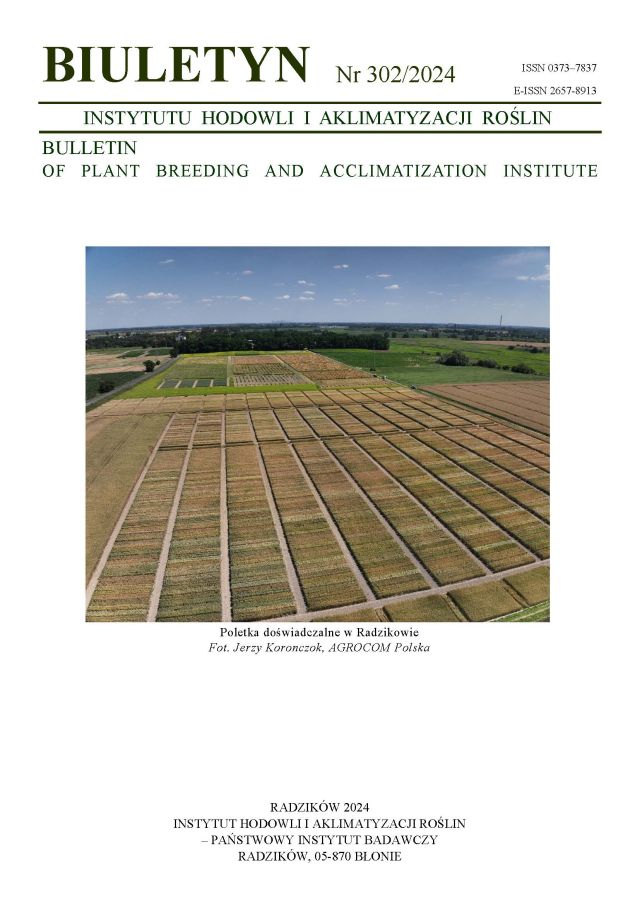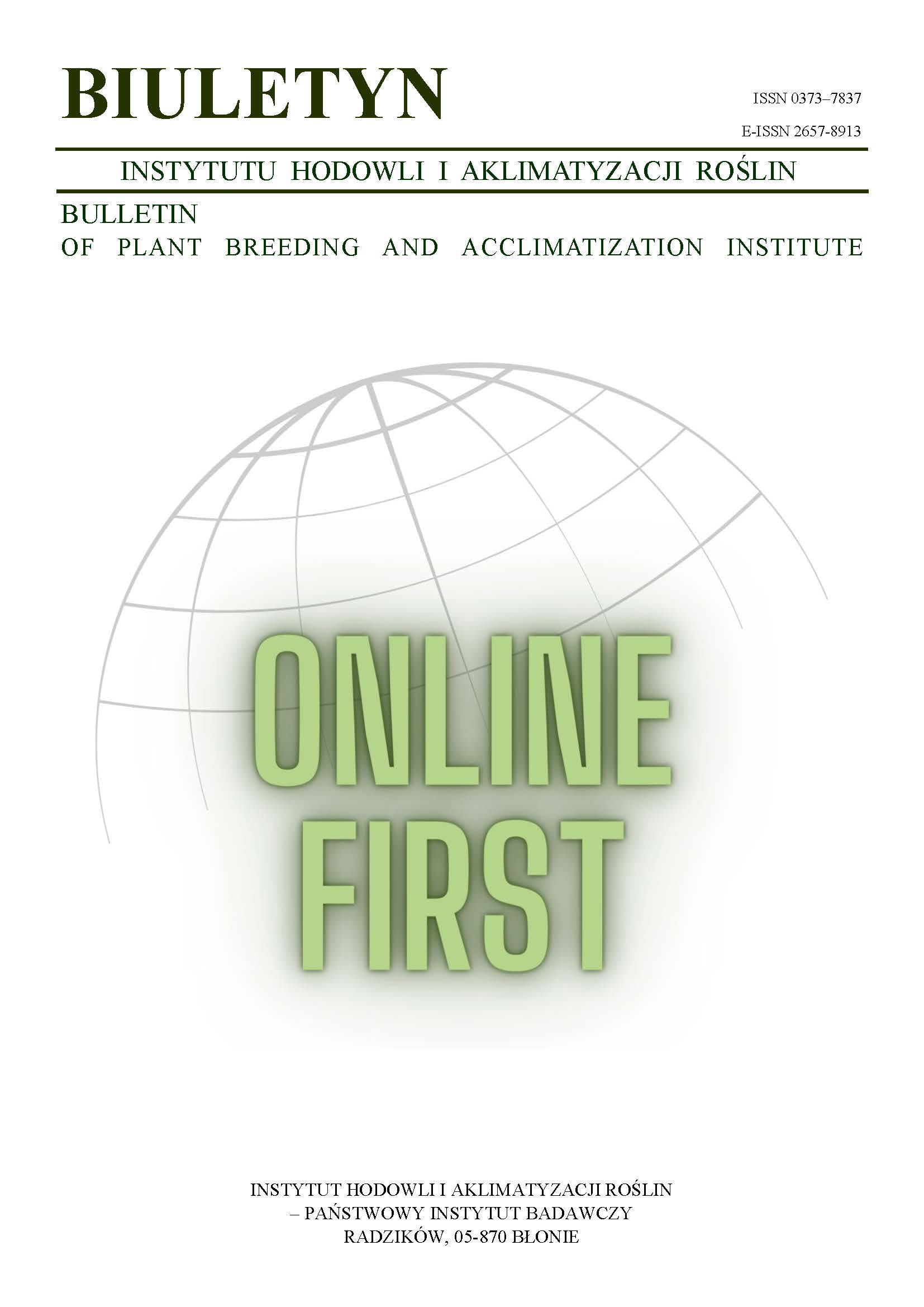Zastosowanie n-wymiarowej macierzy kropkowej do analizy zmienności genetycznej roślin
Andrzej Kasperski
A.Kasperski@wnb.uz.zgora.plWydział Nauk Biologicznych, Katedra Biotechnologii, Uniwersytet Zielonogórski, ul. Szafrana 1 65-516 Zielona Góra (Poland)
Renata Kasperska
Instytut Inżynierii Bezpieczeństwa i Nauk o Pracy, Uniwersytet Zielonogórski, ul. Szafrana 4 65-516 Zielona Góra (Poland)
Abstrakt
Celem pracy jest przedstawienie możliwości wykorzystania nowej metody do analizy zmienności genetycznej organizmów, w tym organizmów o znaczeniu przemysłowym. Zaproponowana metoda działa na dwóch poziomach — na poziomie porównań aminokwasów oraz na poziomie porównań ich kodonów, tj. na poziomie kodu genetycznego. W pracy przedstawiono analizę inhibitorów proteinaz z nasion dyniowatych oraz analizę cytochromu c wybranych roślin uprawnych. Ponadto, za pomocą nowej metody dwupoziomowej analizy zmienności genetycznej otrzymano wyniki, które wykorzystano do interpretacji drzew filogenetycznych zbudowanych dla analizowanych sekwencji.
Słowa kluczowe:
n-wymiarowa macierz kropkowa, statystyczna ocena przyrównań, transwersja, tranzycja, zmienność genetycznaBibliografia
Dereeper A., Guignon V., Blanc G., Audic S., Buffet S., Chevenet F., Dufayard J. F., Guindon S., Lefort V., Lescot M., Claverie J.M., Gascuel O. 2008. Phylogeny.fr: robust phylogenetic analysis for the non-specialist. Nucleic Acids Res. 36: 465 — 469.
Google Scholar
Hall B. 2008. Łatwe drzewa filogenetyczne. Wydawnictwa Uniwersytetu Warszawskiego, Warszawa.
Google Scholar
Higgs P. G., Attwood T. K. 2005. Bioinformatics and Molecular Evolution. Blackwell Publishing Company, Oxford.
Google Scholar
Janaszek M., Mańkowski D. R., Kozdój J. 2011. Sieci neuronowe typu MLP w prognozowaniu plonu jęczmienia jarego. Biul. IHAR 259: 93 — 112.
Google Scholar
Kasperski A., Kasperska R. 2012. A novel method of sequence similarity evaluation in n-dimensional sequence space. Curr. Bioinformatics 7: 295 — 303.
Google Scholar
Kasperski A., Kasperska R. 2014. Identification of protein family representatives. Curr. Bioinformatics 9: 414 — 425.
Google Scholar
Kasperski A., Sun K., Tian Y. 2016. New approach to control of the dissolved oxygen concentration in a biomass-driven self-cycling biochemical process. Chem. Eng. Commun. 203 (1): 75 — 93.
Google Scholar
Kuśka J., Leluk J., Lesyng B. 2005. Zmienność mutacyjna w homologicznych rodzinach kinaz. Bio-Algorithms and Med-Systems 1 (1/2): 125 — 128.
Google Scholar
Leluk J. 1998. A new algorithm for analysis of the homology in protein primary structure. Comput. Chem. 22 (1): 123 — 131.
Google Scholar
Leluk J. 2000 a. Serine proteinase inhibitor family in squash seeds: mutational variability mechanism and correlation. Cell. Biol. Mol. Lett. 5: 91 — 106.
Google Scholar
Leluk J. 2000 b. Regularities in mutational variability in selected protein families and the Markovian model of amino acid replacement. Comput. Chem. 24(1): 659 — 672.
Google Scholar
Leluk J., Hanus-Lorenz B., Sikorski A. F. 2001. Application of genetic semihomology algorithm to theoretical studies on various protein families. Acta Biochim. Pol. 48: 21 — 33.
Google Scholar
Leluk J., Konieczny L., Roterman I. 2003. Search for structural similarity in proteins. Bioinformatics 19: 117 — 124.
Google Scholar
Tamura K., Stecher G., Peterson D., Filipski A. i Kumar S. 2013. MEGA6: Molecular Evolutionary Genetics Analysis version 6.0. Mol. Biol. Evol. 30: 2725 — 2729.
Google Scholar
Thompson J. D., Higgins D. G., Gibson T. J. 1994. CLUSTAL W: improving the sensitivity of progressive multiple sequence alignment through sequence weighting, position-specific gap penalties and weight matrix choice. Nucleic Acids Res. 22: 4673 — 4680.
Google Scholar
Xiong J. 2006. Essential Bioinformatics, Cambridge University Press.
Google Scholar
Autorzy
Andrzej KasperskiA.Kasperski@wnb.uz.zgora.pl
Wydział Nauk Biologicznych, Katedra Biotechnologii, Uniwersytet Zielonogórski, ul. Szafrana 1 65-516 Zielona Góra Poland
Autorzy
Renata KasperskaInstytut Inżynierii Bezpieczeństwa i Nauk o Pracy, Uniwersytet Zielonogórski, ul. Szafrana 4 65-516 Zielona Góra Poland
Statystyki
Abstract views: 268PDF downloads: 106
Licencja
Prawa autorskie (c) 2015 Andrzej Kasperski, Renata Kasperska

Utwór dostępny jest na licencji Creative Commons Uznanie autorstwa – Na tych samych warunkach 4.0 Miedzynarodowe.
Z chwilą przekazania artykułu, Autorzy udzielają Wydawcy niewyłącznej i nieodpłatnej licencji na korzystanie z artykułu przez czas nieokreślony na terytorium całego świata na następujących polach eksploatacji:
- Wytwarzanie i zwielokrotnianie określoną techniką egzemplarzy artykułu, w tym techniką drukarską oraz techniką cyfrową.
- Wprowadzanie do obrotu, użyczenie lub najem oryginału albo egzemplarzy artykułu.
- Publiczne wykonanie, wystawienie, wyświetlenie, odtworzenie oraz nadawanie i reemitowanie, a także publiczne udostępnianie artykułu w taki sposób, aby każdy mógł mieć do niego dostęp w miejscu i w czasie przez siebie wybranym.
- Włączenie artykułu w skład utworu zbiorowego.
- Wprowadzanie artykułu w postaci elektronicznej na platformy elektroniczne lub inne wprowadzanie artykułu w postaci elektronicznej do Internetu, lub innej sieci.
- Rozpowszechnianie artykułu w postaci elektronicznej w internecie lub innej sieci, w pracy zbiorowej jak również samodzielnie.
- Udostępnianie artykułu w wersji elektronicznej w taki sposób, by każdy mógł mieć do niego dostęp w miejscu i czasie przez siebie wybranym, w szczególności za pośrednictwem Internetu.
Autorzy poprzez przesłanie wniosku o publikację:
- Wyrażają zgodę na publikację artykułu w czasopiśmie,
- Wyrażają zgodę na nadanie publikacji DOI (Digital Object Identifier),
- Zobowiązują się do przestrzegania kodeksu etycznego wydawnictwa zgodnego z wytycznymi Komitetu do spraw Etyki Publikacyjnej COPE (ang. Committee on Publication Ethics), (http://ihar.edu.pl/biblioteka_i_wydawnictwa.php),
- Wyrażają zgodę na udostępniane artykułu w formie elektronicznej na mocy licencji CC BY-SA 4.0, w otwartym dostępie (open access),
- Wyrażają zgodę na wysyłanie metadanych artykułu do komercyjnych i niekomercyjnych baz danych indeksujących czasopisma.














